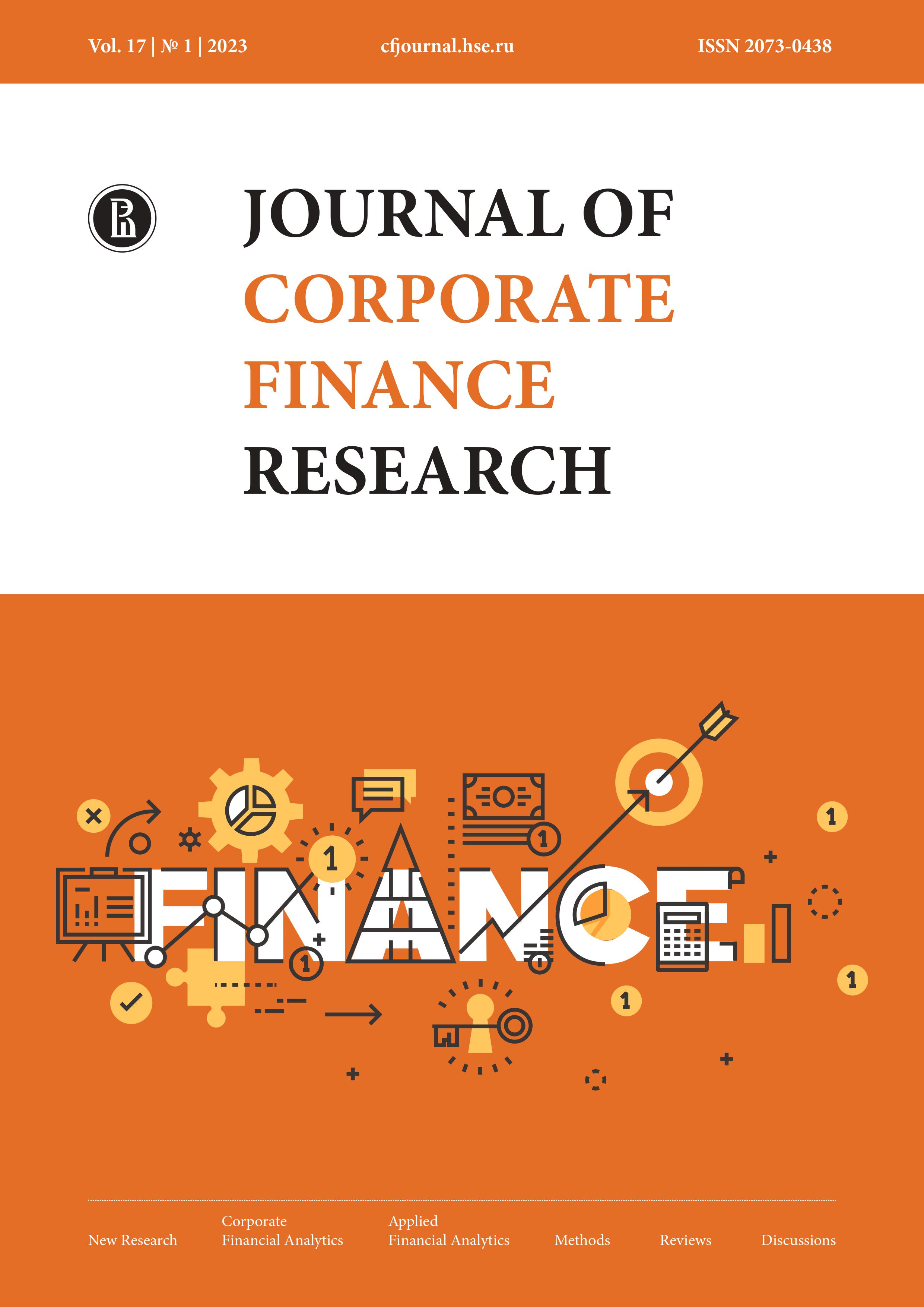Developing a Scoring Credit Model Based on the Methodology of International Credit Rating Agencies
Abstract
The purpose of this work is to examine the relationship of various financial and non-financial (qualitative) factors of performance of non-financial companies and their credit ratings.
We developed the scoring model which was based on the methodologies of international and Russian rating agencies. The modelled ratings of non-financial companies for 2018–2020 were compared with actual ratings assigned by the rating agencies and discrepancies were explained. The sample includes companies from retail, protein and agriculture, steel, oil and gas sectors from Russia, USA, Luxembourg, England, Canada, India, Ukraine and Brazil.
The paper proved that addition of business and environmental, social and governance factors improved the quality ofscoring models in comparison to those including only financial metrics. There are strong patterns in the resulting ratings of companies for some industries. Retail industry companies are associated with high sales indicators, while steel industry companies have high interest expenses coverage ratios. Oil and gas industry companies mostly show high results in reserves coefficients.
The study developed a credit rating forecasting tool that emulates the work of analysts of rating agencies and therefore has a high predictive power. The developed model can be used by financial market practitioners to predict the credit ratings of Russian companies in the face of the refusal of international rating agencies to rate Russian issuers.
Downloads
References
. Zaidi D. The indisputable role of credit ratings agencies in the 2008 collapse, and why nothing has changed. Truthout. Mar. 19, 2016. URL: https://truthout.org/articles/the-indisputable-role-of-credit-ratings-agencies-in-the-2008-collapse-and-why-nothing-has-changed/ (accessed on 10.07.2021).
Glushenkova M. Intermediaries of ruin. Kommersant Den’gi. Jun. 01, 2009. URL: https://www.kommersant.ru/doc/1179079 (accessed on 12.11.2021). (In Russ.).
Factors behind the growing popularity of ESG investing. Nasdaq. Apr. 24, 2021. URL: https://www.nasdaq.com/articles/factors-behind-the-growing-popularity-of-esg-investing-2021-04-24
Bodnar G.M., Consolandi C., Gabbi G., Jaiswal‐Dale A. Risk management for Italian non‐financial firms: Currency and interest rate exposure. European Financial Management. 2013;19(5):887-910. https://doi.org/10.1111/j.1468-036X.2012.00659.x DOI: https://doi.org/10.1111/j.1468-036X.2012.00659.x
Lehmann B. Is it worth the while? The relevance of qualitative information in credit rating. SSRN Electronic Journal. 2003. https://doi.org/10.2139/ssrn.410186 DOI: https://doi.org/10.2139/ssrn.410186
Grunert J., Norden L., Weber M. The role of non-financial factors in internal credit ratings. Journal of Banking & Finance. 2005:29(2):509-531. https://doi.org/10.1016/j.jbankfin.2004.05.017 DOI: https://doi.org/10.1016/j.jbankfin.2004.05.017
Kiesel F., Lücke F. ESG in credit ratings and the impact on financial markets. Financial Markets, Institutions & Instruments. 2019;28(3):263-290. https://doi.org/10.1111/fmii.12114 DOI: https://doi.org/10.1111/fmii.12114
Zadorozhnaya T.M. The credit ratings of emitters defined by rating agencies. Rossiiskoe predprinimatel'stvo = Russian Journal of Entrepreneurship. 2012;(14):85-89. (In Russ.).
Singal M. Firm credit rating as a measure of organizational and financial performance. Journal of Business & Financial Affairs. 2013;2(3):1-2. https://doi.org/10.4172/2167-0234.1000e135 DOI: https://doi.org/10.4172/2167-0234.1000e135
Karminsky А.М. Corporate rating models for emerging markets. Korporativnye finansy = Journal of Corporate Finance Research. 2011;5(3):19-29. (In Russ.). https://doi.org/10.17323/j.jcfr.2073-0438.5.3.2011.19-29 DOI: https://doi.org/10.17323/j.jcfr.2073-0438.5.3.2011.19-29
Karminsky A.M. Credit ratings and their modeling. Moscow: LitRes; 2020. 305 p. (In Russ.).
Bergrem B.H. The determinants of creditworthiness: An empirical study of the relationship between credit ratings and financial ratios in the E&P industry. Master thesis in financial economics. Bergen: Norwegian School of Economics; 2014. 94 p. URL: https://openaccess.nhh.no/nhh-xmlui/bitstream/handle/11250/218454/Masterthesis.pdf?sequence=1&isAllowed=y
Rybalka А.I. Modeling the probability of default in the construction sector: Factors of corporate governance. Korporativnye finansy = Journal of Corporate Finance Research. 2017;11(3):79-99. (In Russ.). https://doi.org/10.17323/j.jcfr.2073-0438.11.3.2017.79-99 DOI: https://doi.org/10.17323/j.jcfr.2073-0438.11.3.2017.79-99
Karminsky A.M., Polozov A.A. Handbook of ratings: Approaches to ratings in the economy, sports, and society. Cham: Springer-Verlag; 2016. 356 p. https://doi.org/10.1007/978-3-319-39261-5 DOI: https://doi.org/10.1007/978-3-319-39261-5
Dyachkova N.F. The comparison of rating scales of Russian and foreign agencies: An empirical study for industrial and financial companies. Korporativnye finansy = Journal of Corporate Finance Research. 2018;12(2):153-170. (In Russ.). https://doi.org/10.17323/j.jcfr.2073-0438.12.2.2018.153-170 DOI: https://doi.org/10.17323/j.jcfr.2073-0438.12.2.2018.153-170
Curtis A.B., Lundholm R.J., McVay S.E. Forecasting sales: A model and some evidence from the retail industry. Contemporary Accounting Research. 2014;31(2):581-608. https://doi.org/10.1111/1911-3846.12040 DOI: https://doi.org/10.1111/1911-3846.12040
Banerjee A., De A. Determinants of corporate financial performance relating to capital structure decisions in Indian iron and steel industry: An empirical study. Paradigm: A Management Research Journal. 2014:18(1):35-50. https://doi.org/10.1177/0971890714540365
Retail industry methodology. Moody’s. 2018. URL: https://www.moodys.com/researchdocumentcontentpage.aspx?docid=PBC_1120379 (accessed on 10.07.2021).
Steel industry methodology. Moody’s. 2017. URL: https://www.moodys.com/researchdocumentcontentpage.aspx?docid=PBC_1074524 (accessed on 10.07.2021).
Protein and agriculture industry methodology. Moody’s. 2019. URL: https://www.moodys.com/researchdocumentcontentpage.aspx?docid=PBC_1113389 (accessed on 10.07.2021).
Oil and gas industry methodology. Moody’s. 2017. URL: https://www.moodys.com/researchdocumentcontentpage.aspx?docid=PBC_1056808 (accessed on 10.07.2021).
Government support methodology. ACRA. 2020. URL: https://www.acra-ratings.ru/storage/content/attachments/7756/20201002_ACRA_GRI_ru.pdf (accessed on 10.07.2021). (In Russ.).
Group belonging methodology. ACRA. 2019. URL: https://www.acra-ratings.ru/storage/content/attachments/7604/20200724_Group_Support_Methodology_ru.pdf (accessed on 10.07.2021). (In Russ.).
ESG rating methodology. Expert RA. 2021. URL: https://raexpert.ru/docbank/5f1/4a8/b0f/3b42bf669a9bbfd305249a6.pdf (accessed on 10.07.2021). (In Russ.).
Copyright (c) 2023 National Research University Higher School of Economics

This work is licensed under a Creative Commons Attribution-NonCommercial-NoDerivatives 4.0 International License.

